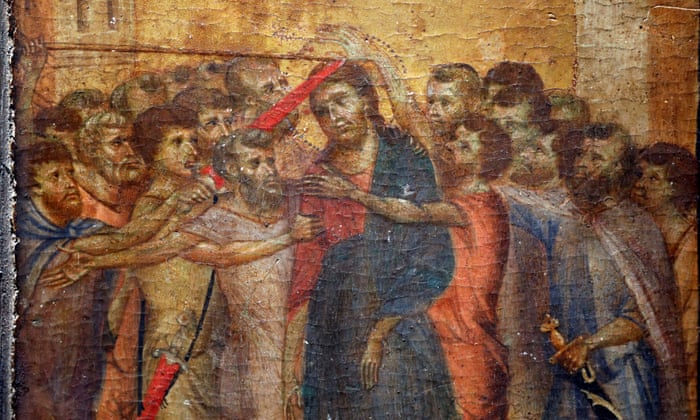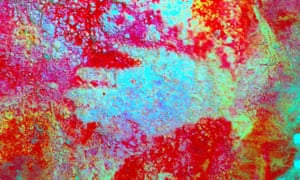This class begins in the mists of ancient prehistory, and traces the evolution of human visual culture through the development of civilizations like Sumeria and Ancient Egypt, the classical Greeks and Romans, up to the very beginnings of the European Renaissance, and covers some of the most surprising, exciting, and beautiful artworks created by humans.
Art 101
Friday, November 20, 2020
Welcome to Art 101
This class begins in the mists of ancient prehistory, and traces the evolution of human visual culture through the development of civilizations like Sumeria and Ancient Egypt, the classical Greeks and Romans, up to the very beginnings of the European Renaissance, and covers some of the most surprising, exciting, and beautiful artworks created by humans.
Tuesday, October 29, 2019
Renaissance painting found in kitchen in France sells for €24m

An tiny early Renaissance masterpiece found in a French woman’s kitchen during a house clearance has fetched more than €24m at auction, making it the most expensive medieval painting ever sold.
Christ Mocked, by the 13th-century Florentine painter Cimabue, had hung for decades above a cooking hotplate in the open-plan kitchen of a 1960s house near Compiègne, north of Paris. It had never attracted much attention from the woman, in her 90s, or her family, who thought it was simply an old icon from Russia. It might have ended up in a bin during the house move this summer had it not been spotted by an auctioneer who had come to value furniture....
Continue reading at The Guardian:https://www.theguardian.com/world/2019/oct/27/renaissance-painting-cimabue-found-kitchen-france-sells-24m-euros-auction
Thursday, September 5, 2019
Friday, August 30, 2019
If you have an LAPL library card...
Sign up for this awesome free movie thing: https://www.lapl.org/kanopy
then watch this https://lapl.kanopy.com/video/finding-altamira
This would be an excellent film about which to write an extra credit report!
If you don't have an LAPL library card, go get one! http://www.lapl.org/about-lapl/borrower-services#apply
This would be an excellent film about which to write an extra credit report!
If you don't have an LAPL library card, go get one! http://www.lapl.org/about-lapl/borrower-services#apply
In the News: SO NEANDERTHALS MADE ABSTRACT ART?
SO NEANDERTHALS MADE ABSTRACT ART? ASTOUNDING DISCOVERY HUMBLES EVERY HUMAN by Jonathan Jones

Up to now we called it the human presence. “The print of the hand says, ‘This is my mark. This is man’,” declared the scientist Jacob Bronowski when he visited caves in northern Spain in his classic TV series The Ascent of Man. Simon Schama visits those same caves in the BBC’s new epic series Civilisations and raves about those same handprints. For what could communicate the curiosity, self-assertion, intelligence, and above all self-consciousness of our unique species Homo sapiens, more clearly that this desire to literally leave our mark?
Except it is not unique to Homo sapiens at all. The potentially epoch-making announcement in the journal Science this week of a new dating for art in some of Spain’s painted caves includes the astounding discovery that a stencilled hand in Maltravieso cave is at least 66,700 years old – a date reached by testing the calcite deposits that have encrusted it over the millennia.
That is long before modern humans are known to have reached Europe on their migration out of Africa. It is also more than 25,000 years before the first paintings made by Homo sapiens in Europe were created at Chauvet in France. The Maltravieso hand is not human, at least not Homo sapiens. It has to be that of a Neanderthal, the early species that hunted the big beasts of ice age Europe before our lot came along, only to mysteriously vanish about 40,000 years ago, soon after our arrival.
“Up to now there have been claims of Neanderthals doing cave art,” says Professor Chris Stringer, Britain’s foremost authority on human evolution. “But it could well have been modern humans. This is clearly before the time when humans were in Europe.” Stringer, one of the researchers who established the now extremely well-proven theory that Homo sapiens evolved in Africa, was not involved in the new dating work but accepts the findings are “a huge breakthrough”.
READ THE REST AT THE GUARDIAN OR ATJ
Also, if you want to go to the horse's mouth, here's the SCIENCE journal article.

Leaving a mark … a color-enhanced hand stencil from La Pasiega in
northern Spain, now dated back 66,700 years. Photograph: Reuters
If you go to the painted caves of Spain and France, crawl through narrow passages and keep your balance on slippery rock floors, you reach the hidden places where ice age hunters made their marks tens of thousands of years ago. Nothing seems more startling than the way they placed hands against the cold rock and blew red ochre out of their mouths to leave fiery images. Of what though?Up to now we called it the human presence. “The print of the hand says, ‘This is my mark. This is man’,” declared the scientist Jacob Bronowski when he visited caves in northern Spain in his classic TV series The Ascent of Man. Simon Schama visits those same caves in the BBC’s new epic series Civilisations and raves about those same handprints. For what could communicate the curiosity, self-assertion, intelligence, and above all self-consciousness of our unique species Homo sapiens, more clearly that this desire to literally leave our mark?
Drawing of Panel 78 in La Pasiega by Breuil et al (1913). The red scalariform (ladder) symbol has a
minimum age of 64,000 years but it is unclear if the animals and other symbols were painted later
Except it is not unique to Homo sapiens at all. The potentially epoch-making announcement in the journal Science this week of a new dating for art in some of Spain’s painted caves includes the astounding discovery that a stencilled hand in Maltravieso cave is at least 66,700 years old – a date reached by testing the calcite deposits that have encrusted it over the millennia.
That is long before modern humans are known to have reached Europe on their migration out of Africa. It is also more than 25,000 years before the first paintings made by Homo sapiens in Europe were created at Chauvet in France. The Maltravieso hand is not human, at least not Homo sapiens. It has to be that of a Neanderthal, the early species that hunted the big beasts of ice age Europe before our lot came along, only to mysteriously vanish about 40,000 years ago, soon after our arrival.
“Up to now there have been claims of Neanderthals doing cave art,” says Professor Chris Stringer, Britain’s foremost authority on human evolution. “But it could well have been modern humans. This is clearly before the time when humans were in Europe.” Stringer, one of the researchers who established the now extremely well-proven theory that Homo sapiens evolved in Africa, was not involved in the new dating work but accepts the findings are “a huge breakthrough”.
READ THE REST AT THE GUARDIAN OR ATJ
Also, if you want to go to the horse's mouth, here's the SCIENCE journal article.
Paleolithic Art
If you missed last week's class, or want to review or expand on what we looked at, the Khan Academy has an excellent overview of Prehistoric art (in fact they are a reliable go-to site for all the Art History periods we'll be covering).

Read at least Paleolithic art, an introduction and I strongly recommend reading through the following short and clear essays on the Origins of rock art in Africa, Apollo 11 Stones, Venus of Willendorf, and Lascaux caves. You can even take the quiz if you like. Here is their video on the Venus of Willendorf:

And here's Werner Herzog's feature documentary about the Chauvet Caves:
Subscribe to:
Comments (Atom)



























